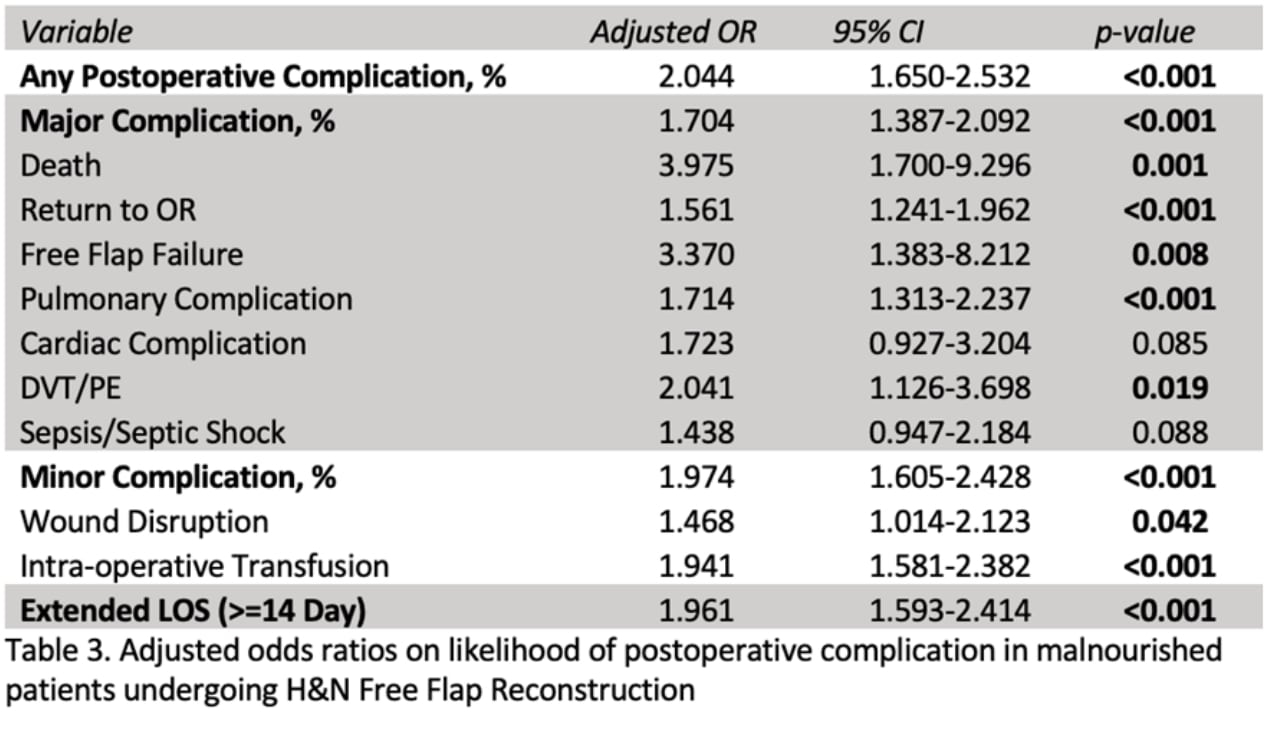Malnutrition in Head and Neck Free Flap Reconstruction as a Predictor of Adverse Outcomes
Isabel Herzog*, Dhruv Mendiratta, Disha Panchal, Priya Mansukhani, Edward S. Lee
New Jersey Medical School, Newark, NJ
Since albumin levels are used as a surrogate for nutritional status, the purpose of this study is to assess whether malnutrition is associated with adverse postoperative outcomes in head and neck (H&N) free flap reconstruction.
The 2006-2018 National Surgical Quality Improvement Program Database was queried for patients undergoing flap procedures of the H&N based on Current Procedure Terminology codes 15756, 15757, 15758, 15842, 20962, 20969, 20955, and 43496. Patients were included if they were operated on by an otolaryngologist or when the primary surgical site was H&N. Nutritional status was categorized as malnourished (preoperative albumin level <3.5g/dl) or normal (preoperative albumin level ≥3.5 g/dl). Major complications included pulmonary complications, cardiac complications, DVT/PE, and sepsis/septic shock. Minor complications included surgical infection, UTI, bleeding, and dehiscence. Extended length of stay (LOS) consisted of a hospital stay of ≥14 days. Data was analyzed via univariate chi-square and multivariate regression analyses.
Patients with hypoalbuminemia were more likely to have smoking history, pulmonary comorbidity, renal comorbidity, disseminated cancer, steroid use, recent weight loss, bleeding disorder, and preoperative transfusion (Table 1). After adjustment for preoperative variance, malnourished patients were more likely to experience death, return to OR, free flap failure, pulmonary complication, DVT/PE, wound disruption, intraoperative transfusion, minor complication, major complication, and extended LOS (Table 2). It should be noted that malnourished patients were 3.370 times more likely to experience flap failure (95% CI [1.383-8.212]; p=0.008) and 3.975 times more likely to experience death (95% CI [1.700-9.626]; p=0.001) than those with normal albumin.
Malnutrition is associated with death, flap failure, minor complications, and other major complications following H&N free flap surgery. Addressing pre-operative nutrition status may ameliorate morbidity and mortality in H&N patients prior to free flap procedures.
Patient demographics in NSQIP patients undergoing H&N Free Flap Reconstruction
Adjusted odds ratios on likelihood of postoperative complications in malnourished patients undergoing H&N Free Flap Reconstruction
Back to 2023 Abstracts


